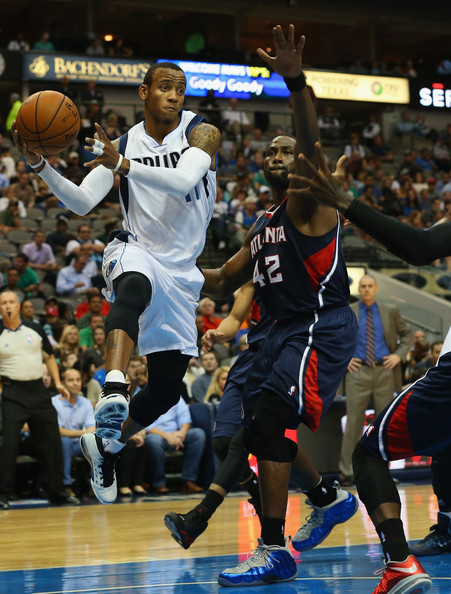
 Monta Ellis has been more than solid for the Dallas Mavericks this year. His overall play has significantly upgraded the Mavs as they look to return to the playoffs after a one year absence. Here’s a look at what Ellis has accomplished in his first 17 games in Dallas:
Monta Ellis has been more than solid for the Dallas Mavericks this year. His overall play has significantly upgraded the Mavs as they look to return to the playoffs after a one year absence. Here’s a look at what Ellis has accomplished in his first 17 games in Dallas:
-Team leader in scoring (21.7 ppg, 10th in the NBA)
-Team leader in assists (5.5 per game)
-Team leader in steals (tied with Dejuan Blair at 1.6 spg)
-15 consecutive games of at least 18-point games to start the season
-A Player Efficiency Rating of 18.57 (10th among Shooting Guards)
-Value Added (VA) of 79.5 (4th among Shooting Guards)
-Estimated Wins Added (EWA) of 2.5 (4th among SGs, 23rd in the NBA)
-All while posting a Usage Rate of 26.6 (1st among SGs, 16th in the NBA)
-726,823 references to himself in the 3rd person
The first four are pretty straightforward, the next four probably mean nothing to you, and the last one is, of course, utter nonsense. The first three bullets simply mean that he has scored more points, stolen more balls and dished out more assists than anyone else on the Dallas Mavericks. The fourth bullet is just a fun fact I found interesting. 15 games is the longest such streak by a player beginning his tenure in Dallas.
The next four categories below….PER, VA, EWA, and Usage Rate are a little more complicated so I have prepared some informative little snippets for your reading pleasure.
Player Efficiency Rating (PER)
PER is the result of John Hollinger’s (look him up, I’m sure his Wikipedia page would be thrilled to have you visit) eternal quest for the ultimate basketball statistic. What PER does is take the positive (points, blocks, assists, rebounds, etc.) and negative (turnovers, personal fouls, missed shots) aspects of a player’s performance and tosses them in a blender with some algorithms until a big sabermetrics nerd decides they’re ready for public consumption.
PER attempts to determine how far above or below average a player is by comparing him to every other player that year. So what is the average? That’s a good question, one that I had myself until I gave it a Google. The league average PER is set at 15.00 every year. A player with a PER greater than 15 is better than average. Of all the players who play at least 20 minutes per game, LeBron James leads the NBA with a PER of 30.53. This gives some validity to the statistic, as LeBron is clearly the best player in basketball today. Unfortunately, this also makes Monta’s PER of 18.57 look a lot less impressive.
This is unfair for a couple of reasons. The first is that post players have a bit of an advantage due to the boost they receive from rebounding and turnover numbers. Post players, on average, don’t touch the ball as much as guards who handle the ball for most of the game which leads to less opportunities for big men to turn the ball over. Furthermore, physics tells us tall people rebound more basketballs than short people. 
The next is that PER rewards versatility above all else. The leaders in PER read in order as follows: LeBron, Anthony Davis, Brook Lopez, Chris Paul, and Kevin Love. LeBron can do everything, and he does. He currently leads his team in points, assists, rebounds and 3-point percentage. He is the most complete player in basketball, racking up numbers in any and all categories. PER was designed to set him apart from his peers and it does. Anthony Davis and Brook Lopez are surprises on this list, but both are excellent rebounders who can score (19.6 and 20 ppg respectively) and block shots (3.9 and 2.7 bpg, respectively). Kevin Love lacks the defensive prowess and shot blocking abilities of the aforementioned big men, but he leads all power forwards with 4.3 assist per game, most of which are a direct result his uncanny ability to turn outlet passes into easy fast break buckets for his team. Chris Paul makes the list by always ranking towards the top of the league in points, assists and steals.
Monta’s game is hurt because it just isn’t all that versatile. He scores points and uses his ability to drive to the basket to create shooting opportunities for his teammates. That’s it. He’s too short to rebound or block shots and he turns to ball over too much for his assist rate to boost his PER. But that hardly means his PER is discouraging. On the contrary, the fact that the man who has been the poster child for NBA inefficiency is above average in a statistical category called Player EFFICIENCY Rating, is something Mavs fans should rejoice in. Even more encouraging, Monta is ranked well above fellow guards Russell Westbrook and Kyrie Irving.
Value Added (VA) and Estimated Wins Added (EWA)
I included these two in the same snippet because they are essentially the same thing. The more valuable you are to your team, the more wins you’ll be responsible for.
Value Added takes into account PER to see how much value a player brings to his team compared to what the average replacement player for his position would. That’s why I only compared him to others who play his position. VA is defined as the estimated number of points a player adds to his team over what a “replacement player” would. In other words, Ellis’ VA of 79.5 means the Mavericks would have scored 79.5 less points if they replaced Monta with a generic NBA shooting guard.
Estimated Wins Added is exactly what it sounds like it is. You calculate EWA by dividing VA by 30 (hence the two being pretty much the same measure). This means that 17 games into the season, Monta Ellis alone is responsible for 2.5 victories. In other words, without Monta, the Mavs would have 7.5 wins-9.5 losses instead of 10 wins-7 losses on the season.
So who are the 3 Two-Guards statistically more valuable to their teams? In order: Aaron Afflalo (Orlando), James Harden (Houston), and Kevin Martin (Minnesota). Isn’t statistics fun?
Usage Rate (USG)
Usage Rate is the percentage of possessions a player uses per 40 minutes. It’s essentially a measure of how often a team utilizes a specific player. The reason I included this statistic was to make a point about Monta Ellis. Ellis leads the Mavericks with more than 3 turnovers a game. That might sound like a ghastly number, but it only makes sense that the guy who has the ball more than anyone else on the team would lead the team in turnovers.
Looking at only a player’s turnover number without perspective is like following someone around all day and only counting how many times they trip. The person who walks more in a day, trips more on average because of math, not coordination impairment (although there are exceptions).
What makes Monta’s performance this year so impressive is that he is above average in just about every advanced efficiency statistic while touching the ball more than any other player in a Dallas Maverick jersey.
Will Monta Ellis be able to maintain his performance through a 82 game season? I don’t know. Numbers aren’t near as effective at predicting the future as they are at interpreting what has already occurred. We’re only about a quarter of the way into the season and the sample size is still relatively small, but the results thus far are definitely encouraging.









